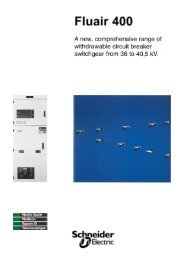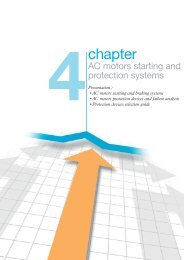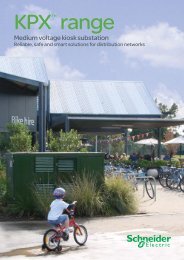Connect - Schneider Electric
Connect - Schneider Electric
Connect - Schneider Electric
Create successful ePaper yourself
Turn your PDF publications into a flip-book with our unique Google optimized e-Paper software.
The Green Plastic program is carried out in collaboration with the<br />
activities, the teams in charge of material purchasing and design<br />
and is included in the Group actions for sustainable development.<br />
The program follows a unique strategy for each type of plastic<br />
focusing around three successive progress plans. A “green” plastic<br />
must therefore:<br />
1. be exempt from potentially toxic substances and have an end-oflife<br />
evaluation scenario (material or energy);<br />
2. come from a production sector that has low CO use (recycled<br />
2<br />
plastic or plastic from renewable sources);<br />
3. come from a resource that does not compete with the food<br />
sector either directly or indirectly, in the case that the Green<br />
Plastic solution makes good use of a raw material from a<br />
renewable source.<br />
3.4 Eco-Production<br />
Approach<br />
<strong>Schneider</strong> <strong>Electric</strong> has extended its environmental system rollout<br />
program beyond only the industrial sites to tertiary sites throughout<br />
the 2009-2011 period. All these sites contribute to reporting, and<br />
therefore to the Group targets. Priority objectives for 2009-2011 to<br />
increase the number of employees working in ISO 14001 certifi ed<br />
sites and to reduce its energy consumption were set within the<br />
framework of the Planet & Society Barometer for the entire Group.<br />
The certifi cation objective helps focus continuous efforts to reduce<br />
the main environmental impacts of the sites, shown in the table on<br />
pages 98-99 :<br />
• energy consumption;<br />
• CO 2 emissions;<br />
• amount of waste produced;<br />
• percentage of waste recovered;<br />
• consumption of water;<br />
• VOC emissions (Volatile Organic Compounds).<br />
Action plans<br />
ISO 14001 certification of Group sites<br />
As soon as the ISO 14001 environmental management standard<br />
was published in 1996, <strong>Schneider</strong> <strong>Electric</strong> decided to certify its<br />
sites. For several years the Group has demanded that all industrial<br />
and logistic sites with more than 50 people be ISO 14001 certifi ed<br />
within two years of their acquisition or creation.<br />
The extension of this internal directive to all tertiary sites with more<br />
than 300 people was enacted in the One program from 2009<br />
and actually launched in 2010. The headquarters of the Group in<br />
France, in Rueil-Malmaison, was thus certifi ed in 2010.<br />
The Group’s priority objective, as set out in the Planet & Society<br />
Barometer, is to enable two thirds of employees to work in<br />
ISO 14001 certifi ed sites. When the One program came to an end<br />
in December 2011, the target had been exceeded with more than<br />
70% of employees working on ISO 14001 sites.<br />
SUSTAINABLE DEVELOPMENT<br />
SCHNEIDER ELECTRIC’S COMMITMENT TO ENVIRONMENTAL PERFORMANCE<br />
The added value that customers expect from “green” plastics lies<br />
in two major areas:<br />
• residential applications exempt from substances of very high<br />
concern, particularly including non-PVC and non-halogen fl ame<br />
retardant product ranges;<br />
• new energy effi cient offers, such as Effi cient Home, which use<br />
plastics with a very low CO impact.<br />
2<br />
<strong>Schneider</strong> <strong>Electric</strong> uses a partnership approach in order to make<br />
progress in research in this area. The Group therefore participates<br />
in collaborative platforms such as the Paristech Mines Bioplastics<br />
Chair or the Axelera competitive clusters initiative (in sustainable<br />
chemistry) and Plastipolis (in plastics engineering).<br />
The challenge for the coming years is to maintain this performance<br />
level by certifying all the new industrial sites within two years of their<br />
acquisition or creation and to continue the new certifi cations of<br />
large tertiary sites.<br />
NB: This has already been achieved, ahead of the two year deadline,<br />
for 26 industrial sites from the Areva D acquisition.<br />
Management of industrial consumption<br />
Water consumption<br />
The Group provides a detailed breakdown of water consumption<br />
that takes into account groundwater and water from the public<br />
network. Water used solely for cooling and then immediately<br />
released without any change is also included in the statistics.<br />
<strong>Schneider</strong> <strong>Electric</strong> reports on the quantities of water consumed<br />
by its sites on a six-monthly basis and monitors the per capita<br />
consumption of water on a like-for-like basis in order to evaluate its<br />
performance from one year to the next.<br />
During the period of the One company program, the overall ecoproduction<br />
approach allowed the Group to reduce its per capita<br />
consumption of water by 6.8% by the end of 2011 in relation to<br />
2010 on a like-for-like basis.<br />
Water is not generally a critical resource in <strong>Schneider</strong> <strong>Electric</strong>’s<br />
industrial processes.<br />
Water is essentially used for sanitary purposes, sometimes for<br />
cooling and in certain sites for surface treatment. In the latter case,<br />
industrial water discharge is subject to treatment that is suitable<br />
in terms of its pollutant potential and discharge into the natural<br />
environment or in a plant subject to a monitoring plan.<br />
As <strong>Schneider</strong> <strong>Electric</strong> industrial production is mainly based on<br />
manual assembly processes or automatic processes for electrical<br />
components and subsets, it has low water consumption and a<br />
negligible impact on water quality.<br />
Nevertheless, in 2011 the group initiated an analysis of industrial<br />
site positions relative to water stress in different regions throughout<br />
the world using the WBCSD tool (World Business Council for<br />
Sustainable Development).<br />
REGISTRATION DOCUMENT 2011 SCHNEIDER ELECTRIC 67<br />
2

















